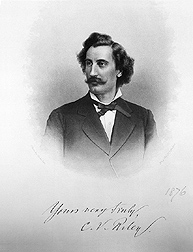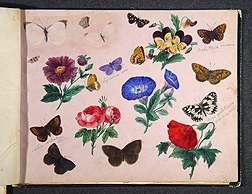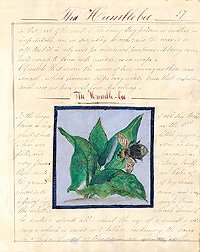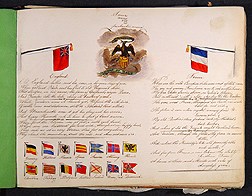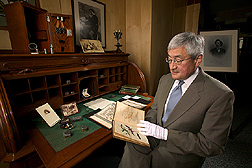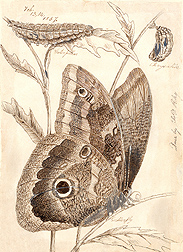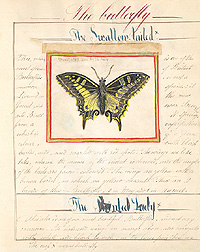Treasures of the National Agricultural Library
Entomologist Charles Valentine Riley’s Artifacts and Papers
|
|
Bugs, butterflies, moths, caterpillars, and blooms of dozens of plants come alive in the graceful, precise drawings of Charles Valentine Riley, the foremost American entomologist of the late 1800s. His accomplishments in what was then a newly emerging profession remain milestones in the field.
Yet Riley was more than an entomologist. A true Renaissance man, he is described by biographers as an artist, poet, writer, journalist, linguist, naturalist, and philosopher. Today, Riley’s papers—dozens of letters, some sketchbooks, and hundreds of other documents—are among the treasures curated by Susan H. Fugate and Sara B. Lee in the Special Collections unit of the ARS National Agricultural Library in Beltsville, Maryland, just outside Washington, D.C.
A Glimpse Into Another Time
|
|
This unique assemblage also includes historical artifacts—a splendid roll-top wooden desk with its small drawers and pigeonholes; the elegant medal presented to him by the French government for outsmarting a vineyard scourge; his Zeiss microscope and its snug wooden case; plus more than 1,000 wood-based printing blocks used in illustrating American Entomologist and American Entomologist and Botanist, of which he was an editor.
But that’s not all. A dozen sepia photographs of Riley, his wife, and their children—five daughters and a son—reveal Riley in his roles as husband and father.
|
|
These papers and artifacts are an important resource for historians, entomologists, and others interested not only in Riley’s accomplishments but also in getting a firsthand picture of what life must have been like in days of Charles Darwin (with whom Riley corresponded), explorer John Wesley Powell (a fellow member of the Cosmos men’s club that Riley helped found in Washington, D.C.), and other notables of that era.
|
|
From Farm Laborer to State Official
A Londoner, Riley came to America in the1860s. He worked as a laborer on a livestock farm in Kankakee, Illinois, then moved to Chicago to write for—and eventually co-publish—Prairie Farmer magazine, all the while broadening and deepening his knowledge of flies, moths, and other plant-plaguing pests.
His growing expertise led to his appointment to the newly established position of entomologist for the State of Missouri in 1868. This became the first in a series of government assignments: He was named chief of the U.S. Entomological Commission in 1877 and later served two terms as chief federal entomologist with the U.S. Department of Agriculture.
Riley may be best known for his pioneering work with biological control—the still-practiced art and science of using one natural organism to control another, harmful one. In Riley’s instance, the targeted pest was cottony cushion scale, a flat-bodied insect that threatened to wipe out southern California orange groves in the 1880s. Riley orchestrated the importing of a natural enemy—vedalia beetles from Australia—to successfully combat the scales. That accomplishment, still one of the world’s most notable successes in biological control, led to Riley’s being regarded as the founder of biological control in America.
At the time of his death in 1895 from injuries he received in a bicycle accident, Riley was honorary curator of the U.S. National Insect Collection at the Smithsonian Institution’s Museum of Natural History in Washington, D.C.
|
|
Today, armchair visitors can get a glimpse of the Riley collection at www.nal.usda.gov/speccoll/collect/riley/. Scholars and others who make their way to the library’s Beltsville headquarters to work with the papers and artifacts will find them a revealing window on America’s past. The collection is rich with the excitement and spirit of discovery that permeated American entomology’s early struggle to stand up firmly on its many legs.—By Marcia Wood, Agricultural Research Service Information Staff.
|
|
Susan H. Fugate and Sara B. Lee are with the USDA-ARS National Agricultural Library, 10301 Baltimore Ave., Beltsville, MD 20705; phone (301) 504-5876, fax (301) 504-7593.
"Treasures of the National Agricultural Library" was published in the October 2005 issue of Agricultural Research magazine.







